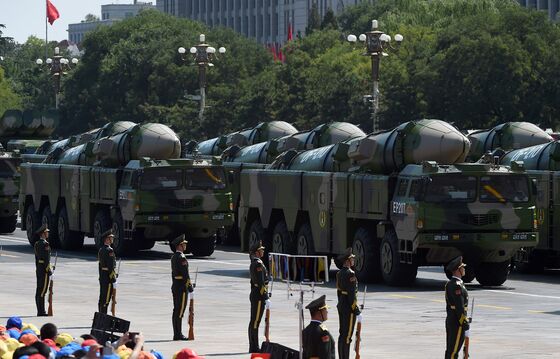
(Bloomberg) -- China’s military executed a coordinated test launch of its top anti-ship ballistic missile into the South China Sea last August to send an “unmistakable message,” the head of the U.S. Indo-Pacific Command Admiral Phil Davidson told a Senate panel on Tuesday.
“These mid-range, anti-ship ballistic missiles are capable of attacking aircraft carriers in the western Pacific,” Davidson said, identifying the DF-21D as the missile tested. “Their employment during a large-scale PLA exercise demonstrates the PLA’s focus on countering any potential third-party intervention during a regional crisis.”
Addressing the Senate Armed Services Committee, Davidson signaled that the use of the missile, even if in a drill, was a turning point for the People’s Liberation Army.
“Notably, the PRC is not merely developing advanced weapons systems but is increasingly employing them in training and exercise scenarios to hone PLA warfighting skills and send an unmistakable message to regional and global audiences,” Davidson said.
The DF-21D is central to China’s strategy of deterring any military action off its eastern coast by threatening to destroy the major sources of U.S. power projection in the region, its carrier battle groups. The then-head of Naval Intelligence Vice Admiral Jack Dorsett told reporters in January 2011 that the Pentagon had underestimated the speed at which China developed and was fielding the DF-21D.
Carrier Destroyers
The missiles are designed for launch to a general location, where the guidance systems take over and spot carriers for attack with warheads intended to destroy the aircraft on decks, airplane-launching gear and control towers. The Pentagon has said they have a range greater than 1,500 kilometers (930 miles).
Reviewing developments in the contested South China Sea, Davidson said Beijing “continues to militarize the region, deploying new equipment to its artificial outposts in 2020 and using forward airfields to support a growing level of military operations by heavy transport, intelligence, and anti-submarine aircraft.”
China’s military also conducts large-scale exercises in the region “with an emphasis on amphibious landing, joint fires, and maritime strike scenarios” as ships and aircraft maintain “a consistent South China Sea presence.” They “are augmented by an armada of China Coast Guard ships, fishing boats, and other para-military forces that serve as force multipliers,” Davidson added.
“These actions -- which are inconsistent with President Xi Jinping’s and Defense Minister Wei Fenghe’s assurances that the PRC would not militarize the SCS -- threaten our allies and partners’ autonomy, jeopardize freedoms of navigation, overflight and other lawful uses of the sea, and compromise regional peace and stability,” he said.
Asked about the implications of China’s military modernization on the U.S. ability to deter a Chinese attack on Taiwan, Davidson said “our conventional deterrent is eroding in the region and it’s because of the vast advances that the Chinese have undertaken.” He also warned of China’s “vast disinformation machine” which he said aims to “corrupt the environment in a way that creates doubt.”
No comments:
Post a Comment